
Clay County is a county located in the U.S. state of Arkansas. As of the 2010 census, the population was 16,083. The county has two county seats, Corning and Piggott. It is a dry county, in which the sale of alcoholic beverages is restricted or prohibited.
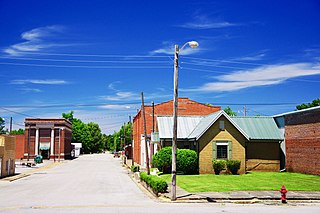
Corning is a city in Clay County, Arkansas, United States. The population was 3,377 at the 2010 census. It is one of the two county seats of Clay County, along with Piggott.

The Allegheny County Courthouse in downtown Pittsburgh, Pennsylvania, is part of a complex designed by H. H. Richardson. The buildings are considered among the finest examples of the Romanesque Revival style for which Richardson is well known.
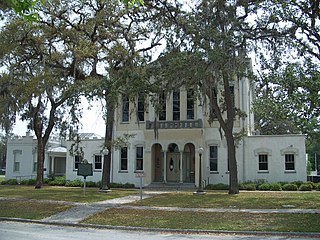
The Clay County Historic Courthouse is a historic county courthouse in Green Cove Springs, Florida. The two-story brick building was built in 1889 and used until 1973. A historical marker commemorates its history. It is located at 915 Walnut Street as part of the county's Historic Triangle which includes the Clay County History Museum, Railroad Depot Display, Old County Jail and Archives Center. On June 20, 1975, it was added to the U.S. National Register of Historic Places. It was designed by Ellis and McClure. This historic location is home to Clay County Teen Court programs and is a venue for events such as mock trials, plays, swearing-in ceremonies, photo shoots and tours. The modern, fully operational Clay County Courthouse is a separate facility located at 825 North Orange Avenue in Green Cove Springs. Employees of the Clay County Clerk's Office oversee the operations of both locations' offices.
Clay County Courthouse or Old Clay County Courthouse may refer to:

The Dallas County Courthouse, built in 1892 of red sandstone with rusticated marble accents, is a historic governmental building located at 100 South Houston Street in Dallas, Texas. Also known as the Old Red Courthouse, it became the Old Red Museum, a local history museum, in 2007. It was designed in the Richardsonian Romanesque style of architecture by architect Max A. Orlopp, Jr. of the Little Rock, Arkansas based firm Orlopp & Kusener. In 1966 it was replaced by a newer courthouse building nearby. On December 12, 1976, it was added to the National Register of Historic Places. In 2005–2007 the building was renovated.

The United States Post Office and Courthouse, also known as Texarkana U.S. Post Office and Federal Building and as Texarkana U.S. Post Office and Courthouse, is located on State Line Avenue in Texarkana, straddling the border between Arkansas and Texas. It is a courthouse of the United States District Court for the Western District of Arkansas and the United States District Court for the Eastern District of Texas.
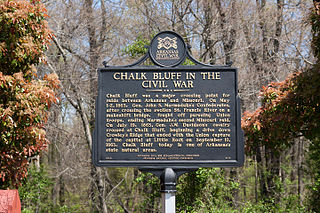
Chalk Bluff was an unincorporated community in Clay County, Arkansas, United States, approximately two miles (3 km) northwest of St. Francis. The town was formed in the 1820s at the point where the St. Francis River cuts through Crowley's Ridge from west to east. The name of the community was derived from the white clay bluff created by this crossing. The founder of the community was Abraham Seitz, who established and operated a ferry crossing and general store in the area from the 1830 until it was destroyed during the Civil War. The community occupied a strategic location and was often referred to in the reports of Union and Confederate forces vying for control of Northeast Arkansas during the war. Several skirmishes occurred near the ferry crossing, one of which was significant it enough to become known as the Battle of Chalk Bluff, which took place in early May 1863. The town was abandoned following the Civil War and most residents moved to the new railroad town, St. Francis, Arkansas. The location was listed on the National Register of Historic Places in 1974.

The Yell County Courthouse is a courthouse in Dardanelle, Arkansas, United States, one of two county seats of Yell County, built in 1914. It was listed on the National Register of Historic Places in 1992. The courthouse is the second building to serve the Dardanelle district of Yell County.
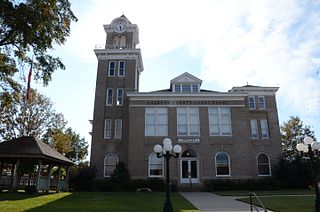
The Calhoun County Courthouse is a courthouse in Hampton, Arkansas, the county seat of Calhoun County, built in 1909. Located within downtown Hampton, the two-story brick building was designed by Frank W. Gibb, who designed 60 courthouses in Arkansas. The courthouse is both a historically and architecturally significant structure, and was listed on the National Register of Historic Places because of this significance in 1976.

The Chicot County Courthouse is a courthouse in Lake Village, Arkansas, the county seat of Chicot County, built in 1956. Located at the end of the Lake Village Commercial Historic District along Lake Chicot, the courthouse is a culturally significant landmark for both its architectural style and historical importance to the county. It was because of this dual significance that the property was listed on the National Register of Historic Places in 2006.

The Arkansas County Courthouse for the Southern District is located at Courthouse Square in the center of De Witt, Arkansas, the seat for the southern county of Arkansas County. It is a three-story brick building with Art Deco styling, designed by Little Rock architect H. Ray Burks and built in 1931. It is one of the finest examples of Art Deco architecture in the state. It is built in the shape of an H, with vault additions made in 1971 the only asymmetrical element. Its main entry is a simple double-leaf entry with transom window, topped by a concrete panel with floral design. This is topped by a pair of large windows, with a concrete panel with signage and clock above and a raised parapet at the top.

The County Home Cemetery is a historic cemetery in Heritage Park, on Heritage Park Road in Piggott, Arkansas. The cemetery occupies about 1.1 acres (0.45 ha) in the center of the park, and is marked by a monument and bench. The park and cemetery are located on the former site of the Clay County poor house, built in 1911. The cemetery contains approximately sixty graves, many unmarked, of indigents who died at the home. The buildings of the facility were demolished in 1954, and the cemetery is the principal tangible reminder of its existence.
The Piggott Commercial Historic District encompasses the original center of the city of Piggott, Arkansas, as originally platted out in 1887. It is centered on the square where the Clay County courthouse is located, buildings facing the courthouse square, and also buildings along some of the adjacent streets. In addition to the courthouse, the district includes the c. 1910 railroad depot, city hall, two churches, the 1930s Post Office building, a cotton gin, and a grain storage yard. The town grew because of the railroad, and the plentiful timber in the area, whose harvesting fueled the early economy in the region. The oldest building in the district is the 1897 Clay County Bank at 188 West Main Street.

The Esso Station was a historic former Esso automotive service station at 287 East Main Street in Piggott, Arkansas. It was a small single-story single-room stuccoed structure, with flanking shed-roofed restroom wings on either side. The main block was fronted by plate glass windows on either side of an entrance sheltered by a small shed-roof portico. It had distinctive Colonial Revival detailing, including a row of soldier bricks at the top of the foundation, and a modillioned cornice. The station was built in 1942. It was demolished sometime after August 2013.

The Piggott National Guard Armory is a historic former Arkansas National Guard facility at 775 East Main Street in Piggott, Arkansas. It is a large single-story concrete block structure, finished with a brick veneer, and topped by a gable roof with a clerestory section at the top. The building was erected in 1956, during a period when armory spaces were undergoing a shift in use and scope. The building was used as an armory until 2005, when it was given to the city by the state.

The Jefferson County Courthouse is the center of county government for Jefferson County, Arkansas. It is located in the Pine Bluff Commercial Historic District in Pine Bluff on the border between the Arkansas delta and Piney Woods.

The Carroll County Courthouse, Eastern District is a historic courthouse at Public Square in the center of Berryville, one of the county seats of Carroll County, Arkansas. Built in 1881 and repeatedly enlarged, it is now a three-story brick structure with a truncated hip roof, and a pair of four-story towers at its front corners, which are topped by pyramidal roofs. The courthouse was built shortly after Berryville replaced Carrollton as the county seat, and before Eureka Springs was chosen as the county's western seat. The building now houses the Heritage Center Museum of the Carroll County Historical Society.

The Franklin County Courthouse, Southern District is located at 607 East Main Street in Charleston, Arkansas. It is a 2-1/2 story brick building, its bays divided by brick pilasters, and its roof topping a metal cornice. Its entrance is framed by brick pilasters with cast stone heads, and topped by a round arch with a cast stone keystone. The building was built in 1923 to a design by Little Rock architect Frank Gibb.
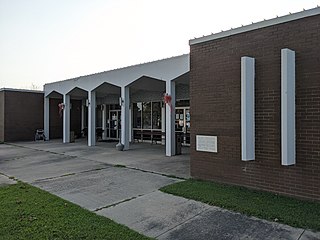
The Clay County Courthouse, Eastern District is located at Courthouse Square in the center of Piggott, one of two county seats of Clay County, Arkansas. It is a single-story masonry structure, built out of concrete with brick facing. The main facade is symmetrical, with a recessed entrance area sheltered by a portico with a zigzag roof. The courthouse was built in 1966–67 to a design by Donnellan & Porterfield, replacing an 1890s Romanesque courthouse designed by Charles L. Thompson. Both this courthouse and that in Corning were built in the wake of a fire which destroyed the old Corning courthouse, and both were designed by Donnellan & Porterfield. Both are locally prominent examples of New Formalism style of Modern architecture.


















